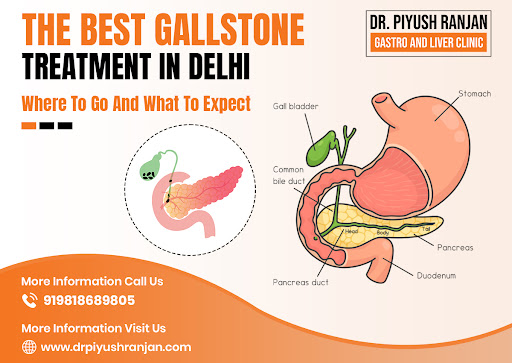Gallstones, medically termed Cholelithiasis, is a prevalent concern in modern-day society, affecting around 10-15% of the adult population. The condition is characterized by the hardened deposits of the digestive fluids that settle inside the gallbladder, causing obstructions.
The condition is often a slowly progressing disease that imposes little to no symptoms in the patients during the early stages. Occurrence of this issue recurs in people with high cholesterol levels, poor lifestyles, and unhealthy dietary habits.
What are Gallstones?
Our gall bladder is a small pear-shaped organ responsible for storing bile. In cases where there are high levels of cholesterol and bilirubin, hardened deposits of these components form inside the gall bladder, leading to the development of gallstones.
Gallstones are of varying shapes, sizes, and densities. Some are sized like a grain of sand, while some can grow into the size of a golf ball. Patients with poor liver function and high cholesterol levels are at heightened risk of developing one or multiple gallstones in their gall bladder.
What are the Symptoms of Gallstones?
As we previously mentioned, most patients with gallstones seldom experience any symptoms at the initial stages. However, as the size of the stones increase, and they multiply in number, the stones start imposing obstructions, which can lead to some significant symptoms.
Most patients with gallstones complain about sharp and chronic pain in the upper-right abdominal region. Eating unhealthy, high-fat foods are common trigger behind gallstone symptoms.
Besides the standard pain in the abdomen and center of the stomach, most patients with advanced stages of gallstones also experience symptoms like:
- Yellowing of the skin
- Spiked fever
- Diarrhea
- Itchiness
- Rapid heartbeat
- Confusion
- Sudden loss in appetite
Keep in mind that these above symptoms are more prevalent in patients who are at an advanced stage of gallstones and need to get surgery to either remove the stones or the gall bladder entirely.
What are the Common types of Gallstones?
There are commonly two types of gallstones that are medically known:
Cholesterol gallstones – These are the most common type of gallstones that appear yellowish in color and often occur from undissolved cholesterol in the digestive fluids of the patient.
Pigment gallstones – These are dark brown (almost black in color) stones that are caused due to excess bilirubin production in the patient.
Understanding the types leads us to the next section, which is the causes of Gallstones.
Three potential scenarios can lead to gallstones in patients:
- Excess cholesterol in the bile
- Excess bilirubin in the bile
- Concentrated bile due to excess presence in the gallbladder
Our gall bladder is a regulatory organ, which means that it needs to empty its components (bile) to be able to function properly. Obstructions to this process lead to a heightened concentration of bile, which leads to the formation of gallstones in the patient.
What are the Complications of Gallstones?
Most patients often take gallstones pretty lightly, thinking it’s going to cure them. That is potentially one of the biggest myths. Gallstones can get progressively worse, especially in patients who rely on an unhealthy and high-fat diet.
If left untreated, gallstones can travel down the bile ducts and cause obstructions to the bile flow, leading to complications in the body. Obstruction of the bile flow often leads to increased pressure in the abdomen, which causes pain, inflammation, and discomfort.
Besides these complications, gallstones can also lead to:
- Gallbladder disease
- Liver disease
- Gallstone pancreatitis
- Cholangitis
- Jaundice
- Malabsorption, etc.
Hence, paying attention to the symptoms is crucial. If you want to keep your health in check, getting a routine screening of the liver and the gall bladder is quintessential.
How are Gallstones Diagnosed?
If you are experiencing recurring pain and discomfort in the abdomen or stomach region, consult a doctor who can help you navigate the issues.
Dr. Piyush Ranjan prioritizes personalized treatment based on a comprehensive and conclusive diagnosis. If he suspects that you might be suffering from gallstones, the diagnosis typically starts with a series of blood tests to check the liver function and for signs of jaundice in the body.
Besides that, a series of imaging tests are also prescribed. They include:
- Ultrasound
- MRCP (Magnetic resonance cholangiopancreatography (MRCP)
- ERCP (Endoscopic retrograde cholangiopancreatography)
Depending on the test results, Dr. Ranjan sits down with the patient to discuss their medical history, following which the next steps in the treatment are discussed.
How are Gallstones Treated?
Treatment for gallstones depends on the size, location, and severity of the gallstones. The doctor can take either one of the two routes – Surgical or Non-Surgical.
#1. Surgical routes
In most gallstone cases, surgery or Cholecystectomy is the most common route of treatment. Under this, you have two types – Laparoscopic cholecystectomy and Open cholecystectomy. Since the gallbladder isn’t an essential organ in the body, patients can undergo surgery to excise the organ and return to a healthy lifestyle.
#2. Non-Surgical routes
Although rare, non-surgical routes of gallstones treatment involve:
Oral dissolution therapy – Uses medications to break down the gallstones and is common for treating cholesterol gallstones.
Shock wave lithotripsy – Involves the use of shock waves to break the gallstones into smaller particles.
Percutaneous drainage of the gallbladder – Involves the use of a needle that’s inserted into the gall bladder to draw out the bile fluid.
The route of treatment your doctor chooses for gallstone removal will entirely depend on the current severity of the condition and also on your medical history.
How to Prevent Gallstones?
Gallstones, in most cases, are a direct consequence of lifestyle factors. However, if you have a familial history of gallstones, there are very few preventive measures you can take.
That said, the following are some tips that can help individuals prevent the risks of gallstones to an extent:
- Avoid fatty and highly processed foods
- Avoid foods with refined sugar
- Avoid foods like lard and cream
- Avoid certain cheese variants with high-fat content
If you are overweight or obese, weight loss plays a crucial role in preventing the risks of gallstones.
Conclusion
Gallstones, despite being so common, is a disease that raises a lot of concerns and complications in the body. If you are experiencing any notable and recurring symptoms, it is essential that you not brush it to the side. Dr. Piyush Ranjan is a leading Gasterologist in Delhi, offering comprehensive and effective treatment to help you regain your quality of life.


